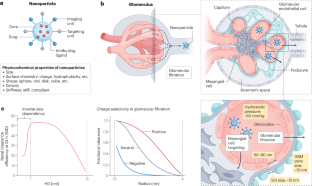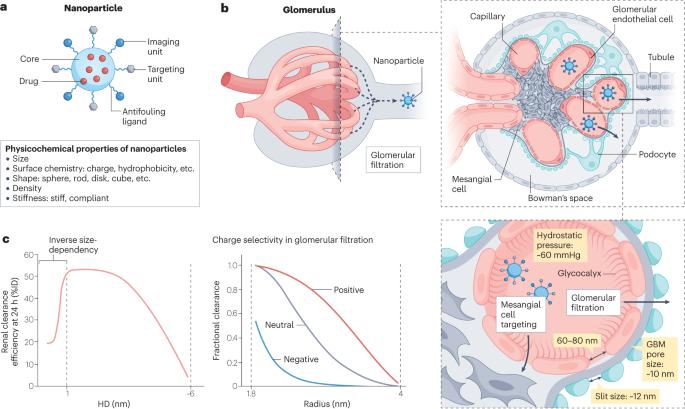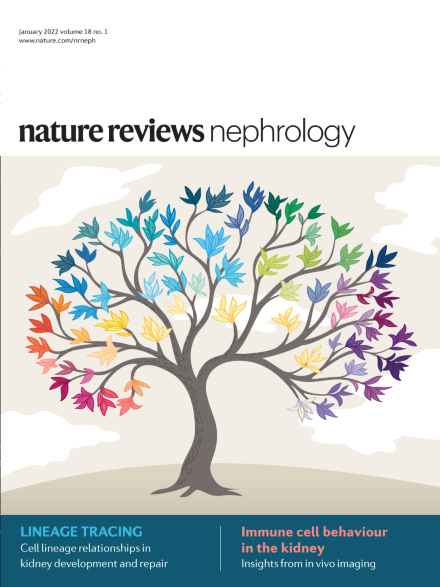肾脏纳米药物靶向肾脏的生理原理。
IF 28.6
1区 医学
Q1 UROLOGY & NEPHROLOGY
引用次数: 0
摘要
肾脏疾病影响着全球 10% 以上的人口,并与相当高的发病率和死亡率相关,这凸显了对新治疗方案的需求。用于治疗肾脏疾病的工程纳米粒子(肾脏纳米药物)就是这样一种选择,它能将靶向治疗药物输送到肾脏的特定区域。虽然与治疗癌症等疾病的纳米药物相比,肾脏纳米药物的发展尚不成熟,但临床前研究结果表明,肾脏纳米药物可能大有可为。然而,肾脏纳米药物体内转运和相互作用的生理原理与癌症纳米药物不同,因此需要全面了解这些原理,才能设计出有效、特异性地靶向肾脏的纳米药物,同时确保未来临床应用中的生物安全性。在此,我们总结了目前对影响肾小球滤过、肾小管摄取、肾小管分泌和纳米颗粒挤出的因素的理解,包括尺寸和电荷依赖性,以及特定转运体和内吞等过程的作用。我们还描述了肾脏疾病如何改变纳米粒子的转运和吸收,并讨论了利用纳米粒子检测和治疗各种肾脏疾病的策略方法。本文章由计算机程序翻译,如有差异,请以英文原文为准。


Physiological principles underlying the kidney targeting of renal nanomedicines
Kidney disease affects more than 10% of the global population and is associated with considerable morbidity and mortality, highlighting a need for new therapeutic options. Engineered nanoparticles for the treatment of kidney diseases (renal nanomedicines) represent one such option, enabling the delivery of targeted therapeutics to specific regions of the kidney. Although they are underdeveloped compared with nanomedicines for diseases such as cancer, findings from preclinical studies suggest that renal nanomedicines may hold promise. However, the physiological principles that govern the in vivo transport and interactions of renal nanomedicines differ from those of cancer nanomedicines, and thus a comprehensive understanding of these principles is needed to design nanomedicines that effectively and specifically target the kidney while ensuring biosafety in their future clinical translation. Herein, we summarize the current understanding of factors that influence the glomerular filtration, tubular uptake, tubular secretion and extrusion of nanoparticles, including size and charge dependency, and the role of specific transporters and processes such as endocytosis. We also describe how the transport and uptake of nanoparticles is altered by kidney disease and discuss strategic approaches by which nanoparticles may be harnessed for the detection and treatment of a variety of kidney diseases. Renal nanomedicines may hold promise for the detection and treatment of a variety of kidney diseases. This Review describes how our understanding of the physiological principles that regulate the glomerular filtration, tubular secretion, luminal tubular uptake and re-elimination of nanoparticles in the kidneys may facilitate the selective targeting of nanomedicines to specific segments of the nephron.
求助全文
通过发布文献求助,成功后即可免费获取论文全文。
去求助
来源期刊

Nature Reviews Nephrology
医学-泌尿学与肾脏学
CiteScore
39.00
自引率
1.20%
发文量
127
审稿时长
6-12 weeks
期刊介绍:
Nature Reviews Nephrology aims to be the premier source of reviews and commentaries for the scientific communities it serves.
It strives to publish authoritative, accessible articles.
Articles are enhanced with clearly understandable figures, tables, and other display items.
Nature Reviews Nephrology publishes Research Highlights, News & Views, Comments, Reviews, Perspectives, and Consensus Statements.
The content is relevant to nephrologists and basic science researchers.
The broad scope of the journal ensures that the work reaches the widest possible audience.
 求助内容:
求助内容: 应助结果提醒方式:
应助结果提醒方式:


